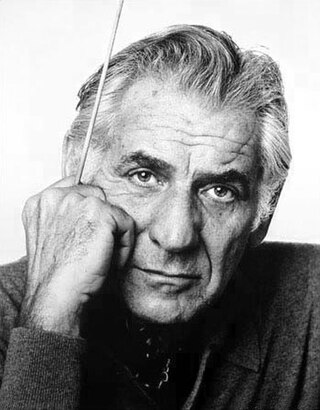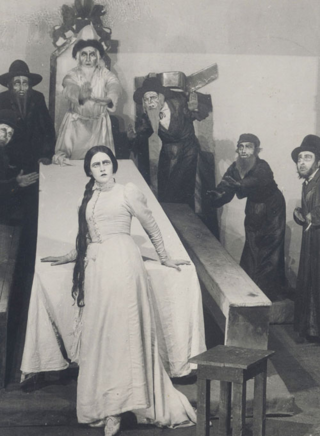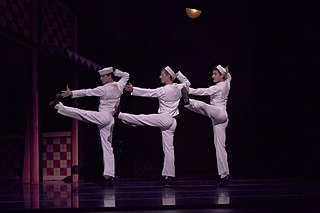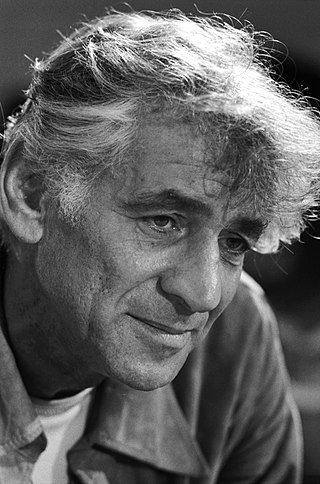Related Research Articles

Leonard Bernstein was an American conductor, composer, pianist, music educator, author, and humanitarian. Considered to be one of the most important conductors of his time, he was the first American-born conductor to receive international acclaim. Bernstein was "one of the most prodigiously talented and successful musicians in American history" according to music critic Donal Henahan. Bernstein's honors and accolades include seven Emmy Awards, two Tony Awards, and 16 Grammy Awards as well as an Academy Award nomination. He received the Kennedy Center Honor in 1981.

In Jewish mythology, a dybbuk is a malicious possessing spirit believed to be the dislocated soul of a dead person. It supposedly leaves the host body once it has accomplished its goal, sometimes after being exorcised.

The Dybbuk, or Between Two Worlds is a play by S. An-sky, authored between 1913 and 1916. It was originally written in Russian and later translated into Yiddish by An-sky himself. The Dybbuk had its world premiere in that language, performed by the Vilna Troupe at Warsaw in 1920. A Hebrew version was prepared by Hayim Nahman Bialik and staged in Moscow at Habima Theater in 1922.
Colin Matthews, OBE is an English composer of contemporary classical music. Noted for his large-scale orchestral compositions, Matthews is also a prolific arranger of other composer's music, including works by Berlioz, Britten, Dowland, Mahler, Purcell and Schubert. Other arrangements include orchestrations of all Debussy's 24 Préludes, both books of Debussy's Images, and two movements—Oiseaux tristes and La vallée des cloches—from Ravel's Miroirs. Having received a doctorate from University of Sussex on the works of Mahler, from 1964–1975 Matthews worked with his brother David Matthews and musicologist Deryck Cooke on completing a performance version of Mahler's Tenth Symphony.

Prelude, Fugue and Riffs is a "written-out" jazz-in-concert-hall composition composed by Leonard Bernstein for a jazz ensemble featuring solo clarinet.
Dance suite may refer to the form of the musical suite known as the suite de danses.

Leonard Bernstein's Symphony No. 2 The Age of Anxiety is a piece for orchestra and solo piano. The piece was composed from 1948 to 1949 in the United States and Israel, and was revised in 1965. It is titled after W. H. Auden's eponymous poem, and dedicated to Serge Koussevitzky.

Michael James Gandolfi is an American composer of contemporary classical music. He chairs the composition department at the New England Conservatory of Music (NEC).
Hershy Kay was an American composer, arranger, and orchestrator. He is most noteworthy for the orchestrations of several Broadway shows, and for the ballets he arranged for George Balanchine's New York City Ballet.

Fancy Free is a ballet composed in 1944 by Leonard Bernstein. The Ballet Theatre premiered the ballet with choreography by Jerome Robbins, scenery by Oliver Smith, costumes by Kermit Love, and lighting by Ronald Bates. The premiere took place on Tuesday, 18 April 1944 at the old Metropolitan Opera House, New York. The New York City Ballet premiere took place on Thursday, 31 January 1980. Fancy Free provided the basis for the later musical, On the Town. A portion of the score was also used in the opening scenes of Alfred Hitchcock's Rear Window.
Suite of Dances is a ballet made by New York City Ballet ballet master Jerome Robbins from his 1974 Dybbuk Variations, which was itself a "cut" version of his Dybbuk from the same year. Suite of Dances' premiere took place on 17 January 1980 at the New York State Theater, Lincoln Center. The eponymous 1974 music to all three versions is that of Leonard Bernstein.
The Dance Suite for Brass Quintet (1989) is the last work completed by the American conductor and composer Leonard Bernstein. It consists of five short movements, each dedicated to a friend.
Ḥalil is a work for flute and chamber orchestra composed by Leonard Bernstein in 1981. The work is named after the halil, an ancient Jewish wind instrument. The work is sixteen minutes in length. Bernstein composed Ḥalil in honor of a young Israeli flutist Yadin Tanenbaum who was killed at the Suez Canal during the 1973 Yom Kippur war. The work was premiered at the Sultan's Pool in Jerusalem on May 27, 1981 with Jean-Pierre Rampal as the soloist and Bernstein conducting the Israel Philharmonic. The American premiere took place at Tanglewood on July 4, 1981 with Doriot Anthony Dwyer as the soloist and members of the Boston Symphony Orchestra.
Joel Spiegelman was an American composer, conductor, concert pianist, harpsichordist, recording artist, arranger, author and professor.

The Missa Brevis by Leonard Bernstein is a musical setting of parts of the mass ordinary in Latin for a mixed a cappella choir with countertenor solo and percussion. It is also Bernstein's last complete choral work, due to his death a year after its completion in 1989.

The Dybbuk: An Opera in Yiddish is an opera in three acts by American composer Solomon Epstein. The libretto was adapted by the composer from S. Ansky's 1914 play The Dybbuk and is allegedly the world's first original Yiddish- language opera. It was premiered and recorded at the Suzanne Dellal Center for Dance and Theater, Tel Aviv, and at Ben-Gurion University, Beersheba, in May 1999. The opera was staged in a 70 minute abridged version using the composer's piano-vocal score. It has not yet been produced with a full orchestra.
Dance Panels is a ballet composed by Aaron Copland in 1959 for a planned collaboration with choreographer Jerome Robbins. After Copland had written the score, Robbins reneged on his commitment and the performance did not take place. Three years later, Copland revised the score for a ballet by the Bavarian State Opera in Munich, Germany, where it premiered on 3 December 1963. The ballet was performed by the New York City Ballet in 1965 and the concert version received its first performance at the Ojai Music Festival the following year. According to Copland biographer Howard Pollack, Dance Panels has proven from a musical standpoint one of the composer's more accessible late scores. While some of its more dissonant moments sound similar to Copland's twelve-tone compositions, other parts recall his earlier stage and screen music. It is also the only one of Copland's six ballets not written to a specific program.

Opening Prayer is a composition for baritone and orchestra, written for the reopening of Carnegie Hall in 1986. Composer Leonard Bernstein set a Hebrew biblical benediction, which concludes a traditional morning service. He derived the music from an earlier piano composition, and later included it in his Jubilee Games in 1988, and in their expansion to the Concerto for Orchestra in 1989, calling the movement now Benediction.

Divertimento, or Divertimento for Orchestra, is a suite of eight orchestral bagatelles by American composer Leonard Bernstein. Completed in 1980 and written to celebrate the centenary of the Boston Symphony Orchestra, it is well-known for featuring the notes B and C in most of its melodic material.
References
|
|